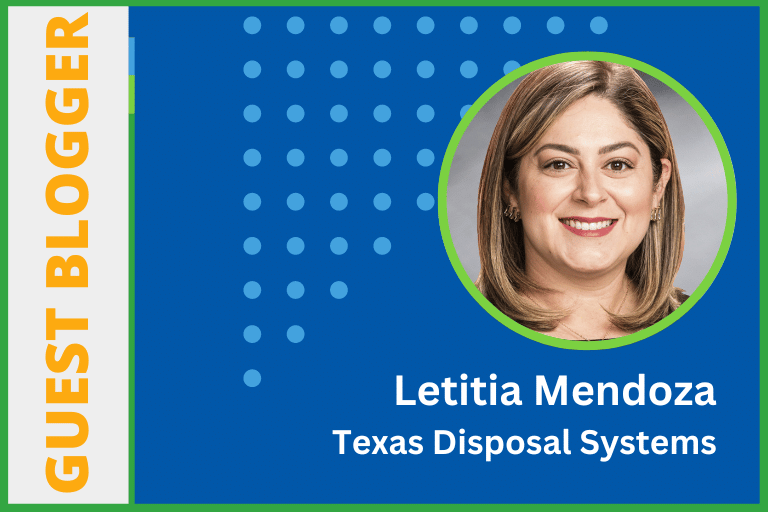Any time of year is the right time to help people build better recycling habits.
At Texas Disposal Systems (TDS), we encourage and educate on recycling year round. We also take seasonality into account and raise awareness about proper methods of disposal when they matter most. This summer, for example, we’ve educating our customers and community about how to properly dispose of hazardous materials — those that present more dangers when temperatures are particularly high.
To help people understand what they should do with things like lithium-ion batteries and other common yet hazardous items, we’ve kicked our education into high gear, leveraging a multi-channel approach to inform and shift behaviors.
Here are the top seven ways we engage and inform, with the ultimate goal of growing recycling efforts and increasing diversion across Central Texas.
1| Create community partnerships
We provide essential services to many cities throughout Central Texas. Through strong relationships with our city partners, we’re able to amplify key messages that will benefit our communities.
In the Austin area, for example, TDS provides recycling services to almost 50 percent of all households.
To expand our messages to citizens in Austin, we partnered with Austin Resource Recovery, the city’s recycling department, to raise awareness of the dangers of including lithium-ion batteries in recycling.
Because of this partnership, customers received important information through multiple channels and from two local entities they know and trust, leading to better outcomes than if either entity had gone it alone.
2| Build business partnerships
For commercial partners, TDS strives to be more than a waste services provider. When companies choose TDS, we also provide education and support as they seek to handle their waste more efficiently and effectively.
For example, TDS partners with event facilities and providers, offices, hotels, restaurants, and other food-service providers. Our in-house sustainability advisor meets with each business client, conducts waste audits and recommends better waste management processes.
Providing education to our clients adds value for them while helping them meet goals for waste diversion and sustainability.
3| Leverage digital tools for recycling education
We share information with customers using multiple channels, including our website, which includes interactive tools for recycling education.
With the Waste Wizard, powered by ReCollect, we’re able to educate people about how to handle household hazardous materials for disposal. The Waste Wizard – a searchable database that includes thousands of materials customizable by location and program – allows customers to search for specific items they want to dispose of, including batteries, paints and flammable liquids.
Users can also get details about the right location for proper disposal so they can create an action plan for getting hazardous materials to one of our approved disposal locations.
In addition, we build out quarterly campaigns around important materials, such as hazardous materials, for our customers that subscribe with our digital tools.
4| Post it on your blog
Through our blog, we provide valuable information on recycling, composting and other waste diversion issues to our customers and residents.
Blogs create awareness for existing customers as well as for people who find them through search engines when they’re looking for related information. These people may not be our customers, but they’re still able to gain beneficial information from our content, which augments our broader environmental mission.
As we create new blog content, we focus on topics that educate and inform our customers. We also strive to create useful content for both individuals and businesses, so both groups can gain specialized knowledge related to their needs. Recent blogs such as “Five Explosive Trash Terrors” and “How to Properly Dispose of Hazardous Waste” reinforce important messages.
5| Reach out with a newsletter
Our monthly newsletter goes to existing customers and reinforces critical information. In this newsletter, we share helpful articles that make recycling appealing and manageable.
We distribute useful tips and news articles, as well as promote community drives or events that allow us to increase diversion. Special services like Christmas tree recycling and appropriate flag disposal are promoted to remind customers they can depend on TDS for less common waste issues, as well as for their typical waste disposal.
We also feature certain issues when we know they might be more relevant. For example, as previously mentioned, hazardous materials problems tend to arise during the summer when high temperatures can make the materials more volatile. During summer months, we use the newsletter to refresh customers’ memories on how to properly handle these items.
Newsletters are a great way to communicate regularly with your customers who may not visit your website frequently beyond initial program launch or signup.
6| Reinforce ideas with social media
TDS actively shares information on social media to reinforce positive disposal behaviors. While some content is promoted across all platforms, we also segment content to align with the audiences most likely to use each and the kind of content that performs best in each space.
For example, our LinkedIn content focuses on resources for business, while our Instagram features short videos and TDS activity in our local community. If there’s an issue or opportunity we want to highlight, we’ll share those details across all social platforms.
On social media, we include a wide variety of content types, so we have many opportunities to catch people’s attention. For example, as we continued our hazardous materials campaign, we used YouTube to share an informative video on lithium-ion battery disposal and promoted the video and other posts — including text and infographics — across other social platforms.
7| Put it on repeat
The marketing “Rule of Seven” says it takes seven repetitions for people to absorb a message. In today’s digital world, it can often take even more to cut through distractions and get that message across.
When we communicate the same message across multiple channels, it increases the likelihood that people will receive it many times and make changes to their behavior. When it comes to safely recycling materials such as hazardous items, those changes can make a significant difference for our waste processing employees and for the safety of our facilities.
Leticia Mendoza is the Director of Marketing and Communications for Texas Disposal Systems (TDS), headquartered in Creedmoor, Texas.





